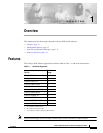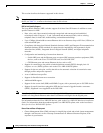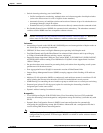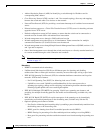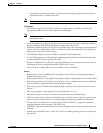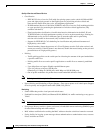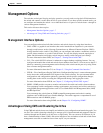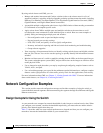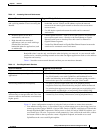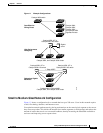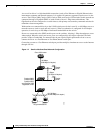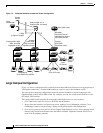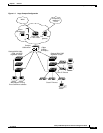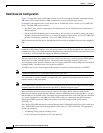
1-9
Catalyst 2950 Desktop Switch Software Configuration Guide
78-14982-01
Chapter 1 Overview
Network Configuration Examples
Bandwidth alone is not the only consideration when designing your network. As your network traffic
profiles evolve, consider providing network services that can support applications such as voice and data
integration and security.
Table 1-3 describes some network demands and how you can meet those demands.
Figure 1-1 shows configuration examples of using the Catalyst switches to create these networks:
• Cost-effective wiring closet—A cost-effective way to connect many users to the wiring closet is to
connect up to nine Catalyst 2900 XL, Catalyst 2950, Catalyst 3500 XL, and Catalyst 3550 switches
through GigaStack GBIC connections. When you use a stack of Catalyst 2950G-48 switches, you
can connect up to 432 users. To preserve switch connectivity if one switch in the stack fails, connect
the bottom switch to the top switch to create a GigaStack loopback, and enable cross-stack
UplinkFast on the cross-stack Gigabit uplinks.
Table 1-2 Increasing Network Performance
Network Demands Suggested Design Methods
Too many users on a single network segment
and a growing number of users accessing the
Internet
• Create smaller network segments so that fewer users share the
bandwidth, and use VLANs and IP subnets to place the network
resources in the same logical network as the users who access those
resources most.
• Use full-duplex operation between the switch and its connected
workstations.
• Increased power of new PCs,
workstations, and servers
• High demand from networked
applications (such as e-mail with large
attached files) and from
bandwidth-intensive applications (such
as multimedia)
• Connect global resources—such as servers and routers to which network
users require equal access—directly to the Fast Ethernet or Gigabit
Ethernet switch ports so that they have their own Fast Ethernet or
Gigabit Ethernet segment.
• Use the Fast EtherChannel or Gigabit EtherChannel feature between the
switch and its connected servers and routers.
Table 1-3 Providing Network Services
Network Demands Suggested Design Methods
High demand for multimedia support
• Use IGMP and MVR to efficiently forward multicast traffic.
High demand for protecting mission-critical
applications
• Use VLANs and protected ports to provide security and port isolation.
• Use VLAN trunks, cross-stack UplinkFast, and BackboneFast for
traffic-load balancing on the uplink ports so that the uplink port with a
lower relative port cost is selected to carry the VLAN traffic.
An evolving demand for IP telephony
• Use QoS to prioritize applications such as IP telephony during
congestion and to help control both delay and jitter within the network.
• Use switches that support at least two queues per port to prioritize voice
and data traffic as either high- or low-priority, based on 802.1P/Q.
A growing demand for using existing
infrastructure to transport data and voice from
a home or office to the Internet or an intranet at
higher speeds
• Use the Catalyst 2950 LRE switches to provide up to 15 Mb of IP
connectivity over existing infrastructure (existing telephone lines).



